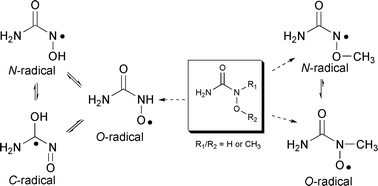Computational study of radicals derived from hydroxyurea and its methylated analogues†
Abstract
Structural and electronic properties and chemical fate of free radicals generated from

* Corresponding authors
a
Institute for Medical Research and Occupational Health, Ksaverska cesta 2, Zagreb, Croatia
E-mail:
valerije@pharma.hr
Fax: +385 1 4856201
Tel: +385 1 6394441
b University of Zagreb, Faculty of Pharmacy and Biochemistry, A. Kovačića 1, Zagreb, Croatia
c Department of Chemistry, LMU München, Butenandstr. 13, München, Germany
Structural and electronic properties and chemical fate of free radicals generated from

 Please wait while we load your content...
Something went wrong. Try again?
Please wait while we load your content...
Something went wrong. Try again?
I. V. Vrček, D. Šakić, V. Vrček, H. Zipse and M. Biruš, Org. Biomol. Chem., 2012, 10, 1196 DOI: 10.1039/C1OB06594G
To request permission to reproduce material from this article, please go to the Copyright Clearance Center request page.
If you are an author contributing to an RSC publication, you do not need to request permission provided correct acknowledgement is given.
If you are the author of this article, you do not need to request permission to reproduce figures and diagrams provided correct acknowledgement is given. If you want to reproduce the whole article in a third-party publication (excluding your thesis/dissertation for which permission is not required) please go to the Copyright Clearance Center request page.
Read more about how to correctly acknowledge RSC content.
 Fetching data from CrossRef.
Fetching data from CrossRef.
This may take some time to load.
Loading related content
